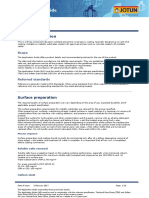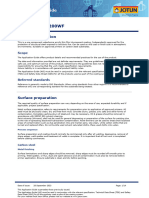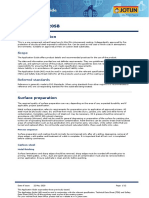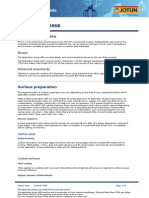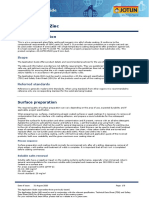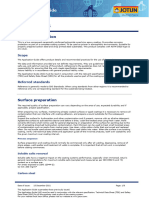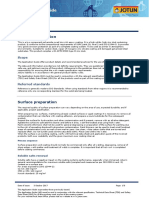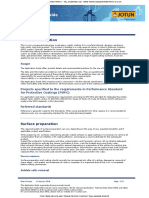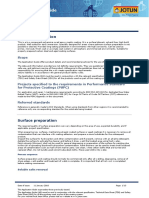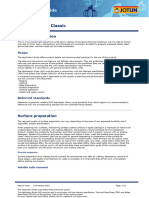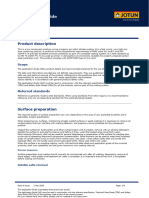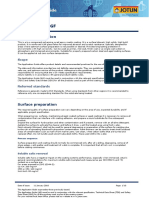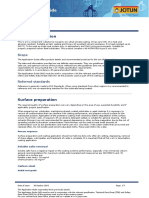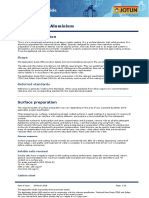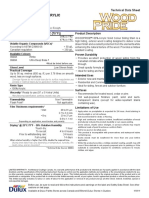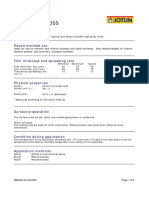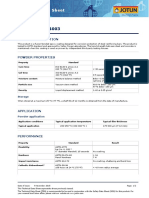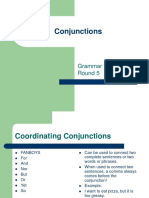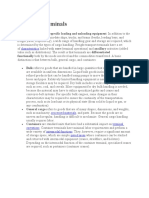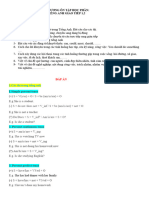Steelmaster 1200WF: Technical Data Sheet Application Guide
Steelmaster 1200WF: Technical Data Sheet Application Guide
Uploaded by
Satish VishnubhotlaCopyright:
Available Formats
Steelmaster 1200WF: Technical Data Sheet Application Guide
Steelmaster 1200WF: Technical Data Sheet Application Guide
Uploaded by
Satish VishnubhotlaOriginal Description:
Original Title
Copyright
Available Formats
Share this document
Did you find this document useful?
Is this content inappropriate?
Copyright:
Available Formats
Steelmaster 1200WF: Technical Data Sheet Application Guide
Steelmaster 1200WF: Technical Data Sheet Application Guide
Uploaded by
Satish VishnubhotlaCopyright:
Available Formats
Technical Data Sheet
Application Guide
Approved 25780 1 25780 acrylic ^(ValidationDate) 1
Steelmaster 1200WF
Product description
This is a one component waterborne acrylic thin film intumescent coating. Independently tested and approved
for fire protection of structural steel exposed to cellulosic fire up to 180 minutes. Suitable for properly prepared
carbon steel substrates.
Scope
The Application Guide offers product details and recommended practices for the use of the product.
The data and information provided are not definite requirements. They are guidelines to assist with efficient and
safe use, and optimum service of the product. Adherence to the guidelines does not relieve the applicator of
responsibility for ensuring that the work meets specification requirements.
Jotuns liability is in accordance with general product liability rules.
The Application Guide (AG) must be read in conjunction with the relevant specification, Technical Data Sheet
(TDS) and Safety Data Sheet (SDS) for all the products used as part of the coating system.
Referred standards
Reference is generally made to ISO Standards. When using standards from other regions it is recommended to
reference only one corresponding standard for the substrate being treated.
Surface preparation
The required quality of surface preparation can vary depending on the area of use, expected durability and if
applicable, project specification.
Metal surface preparation refers to requirements for preparation prior to application of approved primers. All
steel must be physically clean, dry and free from mud, concrete slurry, grease, zinc salts and other forms of
contamination. Complete washing down of steelwork may be necessary. Oil & grease should be removed in
accordance with SSPSC SP1 solvent cleaning.
Paint solvents (thinners) shall not be used for general degreasing or preparation of the surface for painting due
to the risk of spreading dissolved hydrocarbon contamination. Paint thinners can be used to treat small localised
areas of contamination such as dye penetration inks and marker pens. Use clean, white cotton cloths that are
turned and replaced often. Do not bundle used solvent saturated cloths. Place used cloths into water.
Process sequence
Surface preparation and coating should normally be commenced only after all welding, degreasing, removal of
sharp edges, weld spatter and treatment of welds is complete. It is important that all hot work is completed
before coating commences.
Carbon steel
Metal finishing
Surface laminations and sharp edges should be removed, sharp edges must be rounded off smooth prior to
priming. Weld spatter, or flux, dust and spent abrasive and all contamination must also be removed before
primer application. Ensure substrate is clean and dry before painting.
Date of issue: 17 August 2017 Page: 1/10
This Application Guide supersedes those previously issued.
The Application Guide (AG) must be read in conjunction with the relevant specification, Technical Data Sheet (TDS) and Safety
Data Sheet (SDS) for all the products used as part of the coating system.
For your nearest local Jotun office, please visit our website at www.jotun.com.
Application Guide
Steelmaster 1200WF
Coated surfaces
Over coating
When applied on coatings past maximum intercoating interval light abrading may be required to achieve proper
intercoat adhesion.
Organic primers/intermediates
Clean, dry and undamaged compatible coating (ISO 12944-4 6.1)
This product must always be applied over a primer approved by Jotun and must be applied within the recoating
interval of the primer as specified. Areas with breakdown, damage, etc. must be prepared to the specified
standard of blast cleaning to Sa 2½ (ISO 8501-1) or power tool cleaning to minimum St 3 (for small areas) and
a coat of primer touched up before the product is applied.
The product has been fire tested as part of a system. For the complete list of approved Jotun primers and other
approved primers please contact Jotun’s technical department.
The typical primer thickness is 75 µm. The maximum recommended dry film thickness of the primer system is
150 µm depending on the type of product used. If the primer system exceeds the maximum recommended DFT
of 150 µm sanding or sweep blasting maybe required to bring down the total DFT of the primer system to below
the specified limit of 150 µm.
If in doubt contact Jotun’s technical department.
Compatibility of Intumescent coatings with zinc rich primers
Zinc rich primers, usually based on epoxy resin or silicate binders, are often used as corrosion protection
coatings on structural steelwork. Weathering or prolonged exposure of the zinc primer will lead to the formation
of zinc salts on the surface of the coating. If subsequent coatings, including intumescent coatings are applied
over this layer of zinc salt, problems will be experienced with inter-coat adhesion. In such situations therefore, it
is essential that the zinc salts are completely removed by washing down with fresh clean water. Hard bristle
brushes maybe used to remove stubborn zinc salts. Where full removal of zinc salts cannot be guaranteed, the
only safe option is to remove the zinc coating and re-prime the steelwork.
The product must not be applied directly over zinc primers. An epoxy tie coat must be applied prior to the
application of the Steelmaster system. The recommended Jotun approved tie coat is Penguard Tiecoat 100
applied at a DFT of 35 µm.
In all cases, the intumescent coating manufacturer must be consulted to confirm the compatibility of the priming
system with the intumescent system and, where applicable, the tie coat.
Application
Environmental conditions
Intumescent coatings require a greater degree of environmental monitoring than conventional coatings.
Intumescent coatings are moisture sensitive and must be protected against high humidity, rain and consequent
water ponding both during application, transportation or during storage prior to being erected at site. Otherwise
blistering/delamination will occur.
Moisture resistance:
Steelmaster coated steelwork must be protected. Steelmaster products will react to high humidity, moisture
condensation, rain and/or any water ponding when exposed. This will cause blistering and delamination of the
intumescent coating. Where a topcoat is specified, application must occur as soon as the final coat of
Steelmaster is fully through dry.
Acceptable environmental conditions - before and during application
Before application, test the atmospheric conditions in the vicinity of the substrate for the dew formation
according to ISO 8502-4.
Date of issue: 17 August 2017 Page: 2/10
This Application Guide supersedes those previously issued.
The Application Guide (AG) must be read in conjunction with the relevant specification, Technical Data Sheet (TDS) and Safety
Data Sheet (SDS) for all the products used as part of the coating system.
For your nearest local Jotun office, please visit our website at www.jotun.com.
Application Guide
Steelmaster 1200WF
Air temperature 10 - 50 °C
Substrate temperature 10 - 50 °C
Relative Humidity (RH) 10 - 80 %
The following restrictions must be observed:
When storing and transporting, the temperature must be between 5 ºC and 25 ºC. Outside of this, it is advisable
to use climatic control. Protect from freezing at all times during storage and transport.
• Only apply the coating when the substrate temperature is at least 3 °C (5 °F) above the dew point
• Do not apply the coating if the substrate is wet or likely to become wet
• Do not apply the coating if the weather is clearly deteriorating or unfavourable for application or curing
• Do not apply the coating in high wind conditions
Where the substrate temperature during application is likely to exceed 40 ºC, it is recommended to apply a thin
coat at DFT 400-500 µm. Allow to dry as per recommended minimum drying time between coats mentioned in
the product technical data sheet. Apply further coats to build up the DFT to the specified thickness as per
loading table/project specification.
It is advisable to apply the product to the steelwork when the building has been made water tight and dry.
Where a topcoat is specified, application must occur as soon as the final coat of Steelmaster is fully through dry.
It is recommended that the ambient conditions are monitored every 4 hours. Where conditions vary it will be
necessary to monitor at least every one or two hours.
Product mixing
Product mixing
Single pack
This product is a high viscosity product. It is possible that this may be effected when stored. It should be mixed
with an air powered mechanical paint mixing tool that is clean and fit for purpose. Mechanically mix for about
1-2 minutes to ensure that the product is mixed to a uniform consistency and to fully incorporate all of the
ingredients into a homogenous mixture.
Slow speed mixers or mechanical mixers are highly recommended to ensure no aeration or air bubbles are
formed during the mixing process.
Manual mixing is not recommended.
Thinner/Cleaning solvent
Do not add thinner. The product is ready to use and should not be thinned.
Cleaning solvent: Fresh water
Spray application
Airless Spray Equipment
Pump ratio (minimum) : 45:1
Pump output (litres/minute) : 1.9-2.6
Pressure at nozzle (minimum) : 200 bar/2900 psi
Nozzle tip (inch/1000) : 19-23
Date of issue: 17 August 2017 Page: 3/10
This Application Guide supersedes those previously issued.
The Application Guide (AG) must be read in conjunction with the relevant specification, Technical Data Sheet (TDS) and Safety
Data Sheet (SDS) for all the products used as part of the coating system.
For your nearest local Jotun office, please visit our website at www.jotun.com.
Application Guide
Steelmaster 1200WF
Filters (mesh) : Remove filters
Material hose length : Maximum 60 meters
Several factors influence, and need to be observed to maintain the recommended pressure at the nozzle. Among
factors causing pressure drop are:
- extended hoses or hose bundles
- extended hose whip-end line
- small internal diameter hoses
- high paint viscosity
- large spray nozzle size
- inadequate air capacity from compressor
- incorrect or clogged filters
Single coat application
The recommended method of application is by heavy-duty airless spray equipment. A typical wet film thickness
(wft) of not more than 1000 µm per coat is highly recommended. If thicker coats are applied sagging may occur
and will also affect the drying and handling time. The minimum and maximum over coating times are given in
the technical data sheet of the product.
The most suitable method and technique will depend on a number of factors such as coating thickness required,
configuration of the steelwork, access to the steelwork, programming of the project, presence of other trade
activity on site, etc.
Multi-coat application method
Where the specified DFT is greater than 700 µm, apply two or more coats to build up the total specified DFT.
Keep the wft to a maximum of 1000 µm per coat. Follow the recommended over coating intervals between coats
as given in the product technical data sheet. Drying time and over coating intervals will depend on local
environmental conditions.
The over coating time between each coat depends on the total DFT required to be built up as a system. The
actual drying time can vary depending on environmental conditions such as air temperature, relative humidity,
weather conditions, ventilation and also the number of coats, total dry film thickness applied, etc. Water
ponding must be avoided. Early exposure of Steelmaster to moisture, rainwater, high humidity or condensation
will cause defects such as blistering and/or delamination.
Other application tools
Brush application
This product is suited for brush application only on small areas. Application rates will always be slow when
compared to airless spray. Multi-coat application by brush to achieve high DFT is neither practical nor
economical. Care should be taken to achieve a uniform DFT.
Equipment cleaning
It is recommended as best practice to use airless spray equipment suited exclusively for spraying waterborne
coatings. Although this is not mandatory, well maintained airless spray equipment will perform well. Alternating
use of solvent and water borne coatings need conditioning of the spray equipment to avoid solvent
contamination of the water borne paint. All equipment containing solvent in the pump, hoses and gun must be
thoroughly cleaned. Before spraying, circulate a suitable thinner such as Jotun Thinner No. 17 through the
equipment, hoses and gun until such time clean solvent flows through them. This should be followed by flushing
with clean fresh water through the pump, hoses and gun until you see clean water flow. Care should be taken to
ensure no water is mixed with Steelmaster when the paint is circulated through the pump, hose and gun. Allow
some of the Steelmaster to flow out into the waste container to ensure that any product mixed with water is not
used for spraying. Mixing of even small quantity of water with Steelmaster can affect the spray properties of the
product.
Date of issue: 17 August 2017 Page: 4/10
This Application Guide supersedes those previously issued.
The Application Guide (AG) must be read in conjunction with the relevant specification, Technical Data Sheet (TDS) and Safety
Data Sheet (SDS) for all the products used as part of the coating system.
For your nearest local Jotun office, please visit our website at www.jotun.com.
Application Guide
Steelmaster 1200WF
Film thickness per coat
Typical recommended specification range
Dry film thickness 210 - 690 μm
Wet film thickness 300 - 1000 μm
All steel sections must be coated with correct film thickness to achieve the required fire rating. Please refer to
the current loading tables. For further advice please contact your local Jotun office.
Note: The film thickness is only achievable by airless spray application in one coat.
Film thickness measurement
Wet film thickness (WFT) measurement and calculation
To ensure correct film thickness, it is recommended to measure the wet film thickness continuously during
application using a painter's wet film comb (ISO 2808 Method 1A). Use a wet-to-dry film calculation table to
calculate the required wet film thickness per coat.
A wet to dry film thickness chart is available on the Jotun Web site.
Dry film thickness (DFT) measurement
The effectiveness of an intumescent coating is controlled by thickness applied to give the appropriate fire rating.
It is essential to ensure that the correct thickness applicable to each section size is obtained according to the
loading tables issued by Jotun. It is the responsibility of the applicator to ensure all coatings are applied in
accordance with this working procedure and that the specified dry film thickness is achieved on each section.
The film thicknesses for Jotun's intumescent coating are included in the Jotun loading tables (Dft). These
thicknesses apply only to the intumescent coating and are not inclusive of any primer coat. Allowance will have
to be made for the thickness of primer & topcoat (deduct) when measuring the overall system.
Primer thickness may be determined either after application in shop, or on site prior to commencement of
application of the intumescent basecoat. It should be a requirement of the contract that steelwork delivered to
site in primed condition should be accompanied by a documented record of primer thickness supplied by the
fabricator. If this is not available, the site contractor must be required to conduct a primer thickness survey
prior to commencement of intumescent application. Establishing the correct primer thickness is important.
Measurement at this stage will more easily facilitate any subsequent corrections which may prove necessary. If
the total intumescent dry film coating thickness, allowing for the underlying primer, is found to be within
specified tolerances, application of the next coat (usually a decorative and/or protective coat) can proceed.
Indentation of the intumescent coating by the measuring instrument probe indicates insufficient hardness of the
intumescent coating and measurements should be deferred. However, if programming requires coating to
proceed urgently, by agreement with the specifier a shim of known thickness can be used to spread the load of
the probe tip on the coated surface, allowing measurement to proceed before the coating has fully hardened.
The dry film thickness of coating and shim together can then be measured and the shim value deducted to give
the coating thickness.
If the total intumescent dry film coating thickness is found to be outside the specified tolerances, the procedure
outlined below.
Correction of inadequate coating thickness
The importance of dry film thickness checking is emphasized where inadequate thickness is identified prior to
application of the final sealer coat / decorative top coat.
In such situations it is a relatively simple exercise to define the extent of the deficient area(s) and to apply
further coat(s) of intumescent product to bring the overall thickness up to acceptable standards.
However, if low thickness is not detected until after the sealer coat / decorative top coat has been applied,
detailed guidance must be sought from the intumescent coating manufacturer. In some circumstances - and
with supporting test evidence - it may be possible to remedy the situation by the application of further coats of
intumescent paint, but in the other extreme it may be necessary to remove previous coatings in order to build
up the necessary fire protection from scratch. Where the intumescent coating thickness exceeds the limits
Date of issue: 17 August 2017 Page: 5/10
This Application Guide supersedes those previously issued.
The Application Guide (AG) must be read in conjunction with the relevant specification, Technical Data Sheet (TDS) and Safety
Data Sheet (SDS) for all the products used as part of the coating system.
For your nearest local Jotun office, please visit our website at www.jotun.com.
Application Guide
Steelmaster 1200WF
stated in the manufacturer’s recommendations, guidance must be obtained from the manufacturer.
Frequency of measurement
The recommended procedure for measuring dry film thickness and the acceptance criteria is based on Section 4.
7 of ASFP Technical Guidance Doument 11.
Sections must be measured in accordance with the following guidelines:
(i) I Sections, Tee Sections and Channels
Webs: Two readings per metre length on each face of web
Flanges: Two readings per metre length on the outer face of each flange
One reading per metre length on the inner face of each flange.
(ii) Square and Rectangular Hollow Sections and Angles:
Two readings per metre length on each face.
(iii) Circular Hollow Sections:
Eight readings per metre length evenly spread around the section
Where members are less than 2 m in length, three sets of readings shall be taken, one at each end and at the
centre of the member. Each set shall comprise the number of readings on each face given by (i), (ii) or (iii)
above, as appropriate.
When taking DFT readings, it is recommended that no readings are taken within 25 mm of the edge of an I
section or within 25 mm of the join of flange to web of an I section.
DFT acceptance criteria
The average dry film thickness (dft) applied to each steel section shall be greater than or equal to the specified
dry film thickness.
Where any single thickness reading is found to be less than 80 % of the specified dft, a further three readings
shall be taken within 200 to 300 mm around the area of the low reading. The initial reading may be considered
isolated if all the additional readings are at least 80 % of the specified nominal value. If one or more of the
additional readings are less than 80 % of the specified nominal value, further readings shall be made to
determine the extent of the area of under thickness. In such cases, low thickness areas identified must be
brought up to the specified dry film thickness before proceeding to the next application stage. Individual dry film
thickness readings of less than 50 % of the specified dft are not acceptable.
The average measured dry film thickness of any face of any member should not exceed 10 % of the
manufacturer’s recommended maximum thickness for the particular member shape and orientation.
Ventilation
Sufficient ventilation is very important to ensure proper drying/curing of the film.
Coating loss
The consumption of paint should be controlled carefully, with thorough planning and a practical approach to
reducing loss. Application of liquid coatings will result in some material loss. Understanding the ways that
coating can be lost during the application process, and making appropriate changes, can help reducing material
loss.
Some of the factors that can influence the loss of coating material are:
- type of spray gun/unit used
- air pressure used for airless pump or for atomization
- orifice size of the spray tip or nozzle
- fan width of the spray tip or nozzle
- the amount of thinner added
- the distance between spray gun and substrate
- the shape of the substrate target
- environmental conditions such as wind and air temperature
Pre-commissioning considerations
Date of issue: 17 August 2017 Page: 6/10
This Application Guide supersedes those previously issued.
The Application Guide (AG) must be read in conjunction with the relevant specification, Technical Data Sheet (TDS) and Safety
Data Sheet (SDS) for all the products used as part of the coating system.
For your nearest local Jotun office, please visit our website at www.jotun.com.
Application Guide
Steelmaster 1200WF
During the above operations damage to the coating system can occur particularly between in-shop applications
through to final erection on site. Due to the relative high film thickness of intumescent systems, coupled with
their drying mechanism, particular care must be taken during handling of steel sections. The paint system
should be allowed to dry for as long as possible before movement to stock or site or before further coating.
Lifting devices should be of suitable material in order to limit the extent of mechanical damage. Contact points
on the coated steel should be protected. If necessary lifting lugs should be incorporated into the fabrication
process to facilitate the lifting of large or complex configurations of steel sections.
Steelmaster coated steelwork must be protected and suitably covered to avoid water ponding. Section pieces
must be stored in a horizontal position with toes down. Provide adequate ventilation and allow air circulation to
facilitate thorough drying. Minimal stacking is recommended.
For transportation of the applied sections from the fabrication yard to the erection site, the complete system
with approved topcoat must be applied. Systems must be allowed to hard dry and approved before movement
to site.
Drying and Curing time
Substrate temperature 10 °C 23 °C 40 °C
Surface (touch) dry 4h 2h 1h
Dried to handle 16 h 6h 4h
Dry to over coat, minimum 16 h 6h 4h
Drying and curing times are determined under controlled temperatures and relative humidity below 80 %, and
at average of the DFT range for the product.
All drying times have been measured at a wet film thickness of 1000 µm.
Topcoating: The minimum overcoating interval of this product with approved topcoats is 48 hours. Prior to
application of topcoat, the applicator must ensure that the specified dry film thickness has been achieved and
the system is dried to handle.
Surface (touch) dry: The state of drying when slight pressure with a finger does not leave an imprint or reveal
tackiness.
Dried to handle: Minimum time before the coated objects can be handled without physical damage.
Dry to over coat, minimum: The shortest time allowed before the next coat can be applied.
The drying time of the intumescent coating system will increase as the DFT of the total system increases, hence
for coating systems higher than 1000 µm DFT the minimum over coating interval of any subsequent coat other
than itself is 48 hours.
The subesequent coat will adhere to the subtrate when applied on top of this product within the given time
frame. However during this period the surface coated with this product should not be exposed to humidity above
80 %. Direct exposure to water without an approved topcoat will have a negative effect on the performance of
the coating system.
Other conditions that can affect drying / curing / over coating
Date of issue: 17 August 2017 Page: 7/10
This Application Guide supersedes those previously issued.
The Application Guide (AG) must be read in conjunction with the relevant specification, Technical Data Sheet (TDS) and Safety
Data Sheet (SDS) for all the products used as part of the coating system.
For your nearest local Jotun office, please visit our website at www.jotun.com.
Application Guide
Steelmaster 1200WF
Topcoating:
Only topcoats approved by Jotun can be applied over Steelmaster products. Contact Jotun’s technical
department for the approved topcoats.
Prior to application of the topcoat ensure that the Steelmaster has been applied to the specified DFT. The
surface must be clean, dry and free of contamination before applying the topcoat.
The minimum over coating time between Steelmaster and the top coat is 48 hours and when the system is dried
to handle. If the system is not dried to handle, the over coating time may be extended.
Topcoat will normally be applied as per specification. For exposure to corrosivity category C2 (ISO 12944-2) a
minimum of one topcoat at 50 µm dft is recommended. For corrosivity categories C3 and C4 Jotun recommends
two topcoats at 50 µm dft per coat.
It is recommended that the total dft of the topcoat does not exceed 125 µm.
Apply using an airless spray machine and follow the instructions contained on the technical data sheets. Topcoat
can be applied on site by brush/roller, where there is no access or limited access and shall be recorded in the
reports.
It is important that the topcoat is applied at the specified dft film thickness. To achieve a uniform finish on an
uneven surface is difficult and may require additional coats. As a guide the wet film thickness of the topcoat
should be measured at regular intervals to ensure the specified dry film thickness is obtained.
Top coated steelwork should not be exposed to direct sunlight and/or elevated temperatures immediately after
application of the topcoat as this may cause blistering due to entrapped solvents within the Steelmaster.
Even when top coated correctly, any contact with pooling or running water must be avoided.
Repair of coating system
It is always recommended that all types of damages are repaired at the earliest opportunity to avoid any
moisture ingress that can lead to degradation of the intumescent coating. The repair method will depend on the
extent of damage.
Substrate preparation:
Ensure exposed substrate is clean, dry and free from any contamination such as grease, oil, or salt formation.
Damage to Steelmaster coating - Depending on the extent of damage lightly abrade the surface or ‘’Cut Out’’
as described below. Ensure the primer is not damaged. If the primer is damaged a priming coat will be necessary
. Apply the Steelmaster to the specified film thickness by airless spray/brush.
Damage to the coating that exposes bare steel - Damage to small areas may be mechanically cleaned by
abrasive sanding to a minimum standard of SSPC SP11. Care must be taken to avoid burnishing of the steel
substrate. Overlapping zones to intact coating shall be masked off to a minimum 200 mm distance to the
damaged area. The surrounding area must be covered so that overspray to the sound coating does not occur
during repair application. Edges of intact coating around damage area shall be feathered to ensure a smooth
transition from the coating to the prepared steel.
Large areas of damage shall be dry abrasive blast cleaned to Sa 2½ (ISO 8501-1) preferably by the use of
vacuum blasting equipment to avoid damage to intact coating.
Apply one coat of the original primer or the recommended repair primer prior to applying Steelmaster to the
specified dry film thickness.
Damage to Topcoat only - If only the topcoat is damaged then remove loose unsound coatings and feather
the rough edges. Ensure the surface is free from contamination, sound and dry before applying the topcoat to
the recommended/specified dry film thickness.
When repairing Steelmaster, the intumescent coating must not be applied over top coated areas. Ensure to limit
the primers/ Steelmaster/topcoat within its own layers of coating on feathered edges.
This repair procedure applies to following areas
a) Areas of mechanical damages due to other site works.
b) Coating damaged due to fixing additional brackets by welding
c) Burn damages due to welding.
d) Any other damages down to bare steel
e) Steelmaster surface damages.
f) Damages caused by high humidity, moisture, entrapped air, etc causing blistering
g) Ensure the surfaces are clean, dry and free from contamination before applying any coating layer.
Cut out:
Cut out the Steelmaster coating at least five centimeters from the damaged/heat affected area, in all directions
back to sound edge (large enough to allow manual/mechanical preparation). In case of scattered spot blistering/
damages caused due to water ingress, moisture, high humidity the blisters need to be cut open. Sand down the
affected area, feather the edges and repair as recommended above. In case of extensive blistering/swelling of
the Steelmaster due to the above reasons the coating needs to be removed to bare/primed steel and repaired as
above.
Date of issue: 17 August 2017 Page: 8/10
This Application Guide supersedes those previously issued.
The Application Guide (AG) must be read in conjunction with the relevant specification, Technical Data Sheet (TDS) and Safety
Data Sheet (SDS) for all the products used as part of the coating system.
For your nearest local Jotun office, please visit our website at www.jotun.com.
Application Guide
Steelmaster 1200WF
Repair Primer:
Jotamastic 70 Grey / Jotamastic 80 Grey / Jotamastic Smart Pack Grey at DFT 75 -100 μm
Patch prime exposed steel only, using Jotamastic 80 Grey / Jotamastic Smart Pack Grey to achieve DFT 75-100
μm, then allow to dry. Take care not to overlap into the adjacent Steelmaster exposed / feathered area, by
proper protection.
Surface finish
The cosmetic finish of Steelmaster products will depend largely on the method of application. Generally airless
spray application will give a superior finish.
ASFP Technical Guidance Document 11 section 2.1.11 outlines three standards of finish:
1. Basic Finish: The coating system achieves the required fire and corrosion protection performance but is not
required to achieve any required standard of finish
2. Decorative Finish: In addition to item 1, a good standard of cosmetic finish is required when viewed from a
distance of 5 meters. Minor orange peel or other textures resulting from application or localized repair is
acceptable.
3. Bespoke Finish: In addition to item 1, the finish coating is required to have a standard of evenness,
smoothness and gloss agreed between specifier and contractor.
Quality assurance
The following information is the minimum required. The specification may have additional requirements.
- Confirm that all welding and other metal work has been completed before commencing pre-treatment and
surface preparation
- Confirm that installed ventilation is balanced and has the capacity to deliver and maintain the RAQ
- Confirm that the required surface preparation standard has been achieved and is held prior to coating
application
- Confirm that the climatic conditions are within recommendations in the AG, and are held during the application
- Confirm that the required number of stripe coats have been applied
- Confirm that each coat meets the DFT requirements in the specification
- Confirm that the coating has not been adversely affected by rain or other factors during curing
- Observe that adequate coverage has been achieved on corners, crevices, edges and surfaces where the spray
gun cannot be positioned so that its spray impinges on the surface at 90° angle
- Observe that the coating is free from defects, discontinuities, insects, abrasive media and other contamination
- Observe that the coating is free from misses, sags, runs, wrinkles, fat edges, mud cracking, blistering, obvious
pinholes, excessive dry spray, heavy brush marks and excessive film build
- Observe that the uniformity and colour are satisfactory
All noted defects shall be fully repaired to conform to the coating specification.
Caution
This product is for professional use only. The applicators and operators shall be trained, experienced and have
the capability and equipment to mix/stir and apply the coatings correctly and according to Jotun's technical
documentation. Applicators and operators shall use appropriate personal protection equipment when using this
product. This guideline is given based on the current knowledge of the product. Any suggested deviation to suit
the site conditions shall be forwarded to the responsible Jotun representative for approval before commencing
the work.
For further advice please contact your local Jotun office.
Health and safety
Please observe the precautionary notices displayed on the container. Use under well ventilated conditions. Do
not inhale spray mist. Avoid skin contact. Spillage on the skin should immediately be removed with suitable
cleanser, soap and water. Eyes should be well flushed with water and medical attention sought immediately.
Accuracy of information
Always refer to and use the current (last issued) version of the TDS, SDS and if available, the AG for this
product. Always refer to and use the current (last issued) version of all International and Local Authority
Standards referred to in the TDS, AG & SDS for this product.
Date of issue: 17 August 2017 Page: 9/10
This Application Guide supersedes those previously issued.
The Application Guide (AG) must be read in conjunction with the relevant specification, Technical Data Sheet (TDS) and Safety
Data Sheet (SDS) for all the products used as part of the coating system.
For your nearest local Jotun office, please visit our website at www.jotun.com.
Application Guide
Steelmaster 1200WF
Colour variation
Some coatings used as the final coat may fade and chalk in time when exposed to sunlight and weathering
effects. Coatings designed for high temperature service can undergo colour changes without affecting
performance. Some slight colour variation can occur from batch to batch. When long term colour and gloss
retention is required, please seek advice from your local Jotun office for assistance in selection of the most
suitable top coat for the exposure conditions and durability requirements.
Reference to related documents
The Application Guide (AG) must be read in conjunction with the relevant specification, Technical Data Sheet
(TDS) and Safety Data Sheet (SDS) for all the products used as part of the coating system.
When applicable, refer to the separate application procedure for Jotun products that are approved to
classification societies such as PSPC, IMO etc.
Symbols and abbreviations
min = minutes TDS = Technical Data Sheet
h = hours AG = Application Guide
d = days SDS = Safety Data Sheet
°C = degree Celsius VOC = Volatile Organic Compound
° = unit of angle MCI = Jotun Multi Colour Industry (tinted colour)
µm = microns = micrometres RAQ = Required air quantity
g/l = grams per litre PPE = Personal Protective Equipment
g/kg = grams per kilogram EU = European Union
m²/l = square metres per litre UK = United Kingdom
mg/m² = milligrams per square metre EPA = Environmental Protection Agency
psi = unit of pressure, pounds/inch² ISO = International Standards Organisation
Bar = unit of pressure ASTM = American Society of Testing and Materials
RH = Relative humidity (% RH) AS/NZS = Australian/New Zealand Standards
UV = Ultraviolet NACE = National Association of Corrosion Engineers
DFT = dry film thickness SSPC = The Society for Protective Coatings
WFT = wet film thickness PSPC = Performance Standard for Protective Coatings
IMO = International Maritime Organization
Disclaimer
The information in this document is given to the best of Jotun's knowledge, based on laboratory testing and
practical experience. Jotun's products are considered as semi-finished goods and as such, products are often
used under conditions beyond Jotun's control. Jotun cannot guarantee anything but the quality of the product
itself. Minor product variations may be implemented in order to comply with local requirements. Jotun reserves
the right to change the given data without further notice.
Users should always consult Jotun for specific guidance on the general suitability of this product for their needs
and specific application practices.
If there is any inconsistency between different language issues of this document, the English (United Kingdom)
version will prevail.
Date of issue: 17 August 2017 Page: 10/10
This Application Guide supersedes those previously issued.
The Application Guide (AG) must be read in conjunction with the relevant specification, Technical Data Sheet (TDS) and Safety
Data Sheet (SDS) for all the products used as part of the coating system.
For your nearest local Jotun office, please visit our website at www.jotun.com.
You might also like
- Assignment of Pre Primary Teacher TrainingDocument6 pagesAssignment of Pre Primary Teacher TrainingNeha Singhal50% (2)
- Edtpa Task 1 Part B - Plans For Learning SegmentDocument16 pagesEdtpa Task 1 Part B - Plans For Learning Segmentapi-302045878No ratings yet
- Jota Armour: Technical Data Sheet Application GuideDocument1 pageJota Armour: Technical Data Sheet Application GuideTamerTamerNo ratings yet
- 14.Kx For Surveillance AlertsDocument31 pages14.Kx For Surveillance AlertsManojNo ratings yet
- Steelmaster 1200Wf: Technical Data Sheet Application GuideDocument11 pagesSteelmaster 1200Wf: Technical Data Sheet Application GuideDominguez MegoNo ratings yet
- Steelmaster 60WB: Technical Data Sheet Application GuideDocument10 pagesSteelmaster 60WB: Technical Data Sheet Application GuideyugandharNo ratings yet
- Steelmaster 1200Wf: Technical Data Sheet Application GuideDocument13 pagesSteelmaster 1200Wf: Technical Data Sheet Application GuideAdi Indra MardaniNo ratings yet
- AG 25780 Steelmaster 1200WF Euk GBDocument14 pagesAG 25780 Steelmaster 1200WF Euk GBOsama KheadryNo ratings yet
- Steelmaster 120Sb: Technical Data Sheet Application GuideDocument12 pagesSteelmaster 120Sb: Technical Data Sheet Application GuidekalstarNo ratings yet
- Data Ketebalan Cat JotunDocument13 pagesData Ketebalan Cat JotunDeniNo ratings yet
- AG 15400 Steelmaster+120SB Euk GBDocument10 pagesAG 15400 Steelmaster+120SB Euk GBparathasiNo ratings yet
- Chemflake SpecialDocument10 pagesChemflake SpecialNabeel K SNo ratings yet
- Jotachar JF750Document17 pagesJotachar JF750samet çelikNo ratings yet
- Jotatemp 540 Zinc: Technical Data Sheet Application GuideDocument8 pagesJotatemp 540 Zinc: Technical Data Sheet Application GuideAdi Indra MardaniNo ratings yet
- Rukovodstvo Po NaneseniyuDocument11 pagesRukovodstvo Po NaneseniyugustinugrahaNo ratings yet
- Resist 86: Technical Data Sheet Application GuideDocument8 pagesResist 86: Technical Data Sheet Application Guidepmendonça_18No ratings yet
- Jotun Galvanite - AgDocument7 pagesJotun Galvanite - AgAvinash LalNo ratings yet
- Tankguard DW: Technical Data Sheet Application GuideDocument10 pagesTankguard DW: Technical Data Sheet Application GuideNico NgNo ratings yet
- AG 45802 Barrier ZEP HS Euk GBDocument8 pagesAG 45802 Barrier ZEP HS Euk GBAkhmad Hata EfendiNo ratings yet
- Tankguard Zinc AGDocument10 pagesTankguard Zinc AGKev RushNo ratings yet
- Chemflake Special Application GuideDocument10 pagesChemflake Special Application GuideMohanadNo ratings yet
- Barrier 80: Technical Data Sheet Application GuideDocument8 pagesBarrier 80: Technical Data Sheet Application GuideAyman JadNo ratings yet
- Jotatemp 250: Technical Data Sheet Application GuideDocument9 pagesJotatemp 250: Technical Data Sheet Application GuideAdi Indra MardaniNo ratings yet
- Jotamastic 90: Technical Data Sheet Application GuideDocument13 pagesJotamastic 90: Technical Data Sheet Application GuideAditya NugrahaNo ratings yet
- Tankguard 412: Technical Data Sheet Application GuideDocument9 pagesTankguard 412: Technical Data Sheet Application GuideEngTamerNo ratings yet
- Tankguard DW: Technical Data Sheet Application GuideDocument10 pagesTankguard DW: Technical Data Sheet Application GuideMina RemonNo ratings yet
- Penguard Express ZP Application GuideDocument8 pagesPenguard Express ZP Application GuidenizamuddinNo ratings yet
- Safeguard Universal AGDocument7 pagesSafeguard Universal AGMar PardalesNo ratings yet
- AG Penguard Universal GB English ProtectiveDocument14 pagesAG Penguard Universal GB English ProtectiveajuhaseenNo ratings yet
- Jotun Jotamastic Plus - Aluminium Application GuideDocument9 pagesJotun Jotamastic Plus - Aluminium Application Guidehendro.saranghaeNo ratings yet
- Jota MasticDocument13 pagesJota MasticSing Yew LamNo ratings yet
- Epoxy HR: Technical Data Sheet Application GuideDocument10 pagesEpoxy HR: Technical Data Sheet Application GuidesufizamaniNo ratings yet
- Barrier: Technical Data Sheet Application GuideDocument8 pagesBarrier: Technical Data Sheet Application GuideANIBALLOPEZVEGANo ratings yet
- Marathon 500Document10 pagesMarathon 500891629No ratings yet
- AG 7740 Tankguard SF Euk GBDocument11 pagesAG 7740 Tankguard SF Euk GBChandran NairNo ratings yet
- Jotamastic 87: Technical Data Sheet Application GuideDocument10 pagesJotamastic 87: Technical Data Sheet Application GuideMina RemonNo ratings yet
- Intumescent Method Statement - UGDC - R00 11Document1 pageIntumescent Method Statement - UGDC - R00 11Hatem RagabNo ratings yet
- Classic Application1Document11 pagesClassic Application1Wa RiNo ratings yet
- Penguard Express ZP: Technical Data Sheet Application GuideDocument8 pagesPenguard Express ZP: Technical Data Sheet Application GuideAzar SKNo ratings yet
- Resist 78: Technical Data Sheet Application GuideDocument7 pagesResist 78: Technical Data Sheet Application GuideMohd YusriNo ratings yet
- Barrier ZEP: Technical Data Sheet Application GuideDocument7 pagesBarrier ZEP: Technical Data Sheet Application GuideNurmalinda SihombingNo ratings yet
- Marathon 500 AGDocument10 pagesMarathon 500 AGAbdul KharisNo ratings yet
- Tankguard Storage: Technical Data Sheet Application GuideDocument14 pagesTankguard Storage: Technical Data Sheet Application GuideEngTamerNo ratings yet
- AG 678 Resist 78 Euk GBDocument9 pagesAG 678 Resist 78 Euk GBRoger Mahilum Jr.No ratings yet
- 1-Technical Data Sheet- Marathon IQ GF (500μm)Document8 pages1-Technical Data Sheet- Marathon IQ GF (500μm)Akram AlhaddadNo ratings yet
- 2-Technical Data Sheet- Marathon IQ GF (500μm)Document8 pages2-Technical Data Sheet- Marathon IQ GF (500μm)Akram AlhaddadNo ratings yet
- Jotamastic 90 GF: Technical Data Sheet Application GuideDocument11 pagesJotamastic 90 GF: Technical Data Sheet Application GuidemanthoexNo ratings yet
- LS Nylon 12 GF Material SpecificationsDocument10 pagesLS Nylon 12 GF Material SpecificationsAlexandreau del FierroNo ratings yet
- Jotacote Universal N10: Technical Data Sheet Application GuideDocument13 pagesJotacote Universal N10: Technical Data Sheet Application GuideMina RemonNo ratings yet
- Jotamastic 70Document9 pagesJotamastic 70Muhammad HanafiNo ratings yet
- Jotaprime Mastic 80 AGDocument8 pagesJotaprime Mastic 80 AGMuthu Sivarama Krishnan Nallaiah100% (2)
- Jotacote Universal N10: Technical Data Sheet Application GuideDocument15 pagesJotacote Universal N10: Technical Data Sheet Application Guidemhd abuNo ratings yet
- Tankguard HB: Technical Data Sheet Application GuideDocument13 pagesTankguard HB: Technical Data Sheet Application Guidewafda hakimulNo ratings yet
- Marathon XHB: Technical Data Sheet Application GuideDocument9 pagesMarathon XHB: Technical Data Sheet Application GuideDamar WardhanaNo ratings yet
- Baltoflake: Technical Data Sheet Application GuideDocument11 pagesBaltoflake: Technical Data Sheet Application GuideNurmalinda SihombingNo ratings yet
- Jotamastic 87: Technical Data Sheet Application GuideDocument10 pagesJotamastic 87: Technical Data Sheet Application GuideMuhammad Fitransyah Syamsuar PutraNo ratings yet
- Resist 5 WF: Technical Data Sheet Application GuideDocument7 pagesResist 5 WF: Technical Data Sheet Application GuideEngTamerNo ratings yet
- Jotamastic 80 Aluminium: Technical Data Sheet Application GuideDocument10 pagesJotamastic 80 Aluminium: Technical Data Sheet Application GuideRohit KambleNo ratings yet
- Barrier 77: Technical Data Sheet Application GuideDocument8 pagesBarrier 77: Technical Data Sheet Application GuideNurmalinda SihombingNo ratings yet
- Penguard Special Application GuideDocument10 pagesPenguard Special Application GuideRaju KCNo ratings yet
- AG 43363 Alkydprimer QD Euk GBDocument8 pagesAG 43363 Alkydprimer QD Euk GBNagendra BurabattulaNo ratings yet
- Residential Asphalt Roofing Manual Design and Application Methods 2014 EditionFrom EverandResidential Asphalt Roofing Manual Design and Application Methods 2014 EditionNo ratings yet
- Your Home Inspected: An Addendum for Residential Home Inspection ReportsFrom EverandYour Home Inspected: An Addendum for Residential Home Inspection ReportsNo ratings yet
- Amerlock 400Document7 pagesAmerlock 400Satish VishnubhotlaNo ratings yet
- Spectracron 110 FD Alkyd Enamel PDFDocument2 pagesSpectracron 110 FD Alkyd Enamel PDFSatish Vishnubhotla0% (1)
- Megaseal TFDocument6 pagesMegaseal TFSatish VishnubhotlaNo ratings yet
- WP 9900 CaenDocument2 pagesWP 9900 CaenSatish VishnubhotlaNo ratings yet
- SteelMaster 1200WF BrochureDocument4 pagesSteelMaster 1200WF BrochureSatish VishnubhotlaNo ratings yet
- Interfine 979Document4 pagesInterfine 979Satish VishnubhotlaNo ratings yet
- Jotachar 1709 BrochureDocument7 pagesJotachar 1709 BrochureSatish VishnubhotlaNo ratings yet
- TdsDocument4 pagesTdsSatish VishnubhotlaNo ratings yet
- Cloverdale Tds 03240Document2 pagesCloverdale Tds 03240Satish VishnubhotlaNo ratings yet
- Tds - Bengalac Gloss - English - Issued.18.11.2002Document3 pagesTds - Bengalac Gloss - English - Issued.18.11.2002Satish VishnubhotlaNo ratings yet
- TDS Jotamastic 70 GB English ProtectiveDocument4 pagesTDS Jotamastic 70 GB English ProtectiveSatish VishnubhotlaNo ratings yet
- Steelmaster 1200WF TDSDocument4 pagesSteelmaster 1200WF TDSSatish VishnubhotlaNo ratings yet
- Jotaguard RBDocument2 pagesJotaguard RBSatish VishnubhotlaNo ratings yet
- Chapter 4,5Document30 pagesChapter 4,5Vranda AgarwalNo ratings yet
- Introduction To AmplifiersDocument25 pagesIntroduction To Amplifiersrahul prasadNo ratings yet
- Conjunctions: Grammar Boot Camp Round 5Document7 pagesConjunctions: Grammar Boot Camp Round 5Encio BonillaNo ratings yet
- Study Guide Assignment For Chapter 32Document3 pagesStudy Guide Assignment For Chapter 32Veronica SandovalNo ratings yet
- Noorul Hadith 007 - May & June 2019Document64 pagesNoorul Hadith 007 - May & June 2019Mohammad Omar FaruqNo ratings yet
- Connors and Other ADHD ScalesDocument3 pagesConnors and Other ADHD ScalesPragnya NidugondaNo ratings yet
- Freight Terminals: CharacteristicsDocument6 pagesFreight Terminals: Characteristicskim jeonNo ratings yet
- Activity 1 - Distribution ManagementDocument2 pagesActivity 1 - Distribution Managementbeverly managaytayNo ratings yet
- PEF 2309 Fundamentos de Mecânica Das Estruturas Timoshenko, S.P.,PWS Publishing Company, 1997, Boston, USA, p.408-410, 580-583. Example 8-4Document6 pagesPEF 2309 Fundamentos de Mecânica Das Estruturas Timoshenko, S.P.,PWS Publishing Company, 1997, Boston, USA, p.408-410, 580-583. Example 8-4Jc FortNo ratings yet
- Broiler Management Handbook 2nd EditionDocument32 pagesBroiler Management Handbook 2nd EditionManlike SasNo ratings yet
- J&K Drainage System Notes - 45026923 - 2024 - 10 - 20 - 22 - 45Document21 pagesJ&K Drainage System Notes - 45026923 - 2024 - 10 - 20 - 22 - 45TAHIR CHOUDHARYNo ratings yet
- Module 7 Week 3 and Week 4Document7 pagesModule 7 Week 3 and Week 4Krisha Mae AgregadoNo ratings yet
- ĐỀ CƯƠNG TIẾNG ANH 2Document22 pagesĐỀ CƯƠNG TIẾNG ANH 2Lương Thanh TùngNo ratings yet
- Open DEFORM™-3D. Make A New Problem Under "Problem" Directory. Problem Setup Window Will Open. Select The Ring Rolling Guiding TemplateDocument13 pagesOpen DEFORM™-3D. Make A New Problem Under "Problem" Directory. Problem Setup Window Will Open. Select The Ring Rolling Guiding Templatevincent02hk_57881301No ratings yet
- Texto Medicina English Oficial-1Document58 pagesTexto Medicina English Oficial-1Alvarez WilNo ratings yet
- Green Bill: Scan & PayDocument6 pagesGreen Bill: Scan & Paymohamed elmakhzniNo ratings yet
- 5 de Thi Hoc Ki 1 Tieng Anh 6 Ilearn Smart World Co Dap An Va Loi Giai Chi Tiet 1671159396Document62 pages5 de Thi Hoc Ki 1 Tieng Anh 6 Ilearn Smart World Co Dap An Va Loi Giai Chi Tiet 1671159396hậu útNo ratings yet
- Zoom.E 8080.manualDocument71 pagesZoom.E 8080.manualdodNo ratings yet
- Importance of OrganisingDocument8 pagesImportance of OrganisingchaimaNo ratings yet
- ATG - SAP Project System Overview 1Document18 pagesATG - SAP Project System Overview 1Adão da luzNo ratings yet
- Parts Catalog: This Catalog Gives The Numbers and Names of Parts On This MachineDocument39 pagesParts Catalog: This Catalog Gives The Numbers and Names of Parts On This MachinePericoNo ratings yet
- Emg 200Document2 pagesEmg 200IrinaNo ratings yet
- MSBI DEVELOPER RESUME FRESHER - SravanDocument3 pagesMSBI DEVELOPER RESUME FRESHER - Sravansravan0% (1)
- fms13 HelpDocument263 pagesfms13 HelpBeto MurguiaNo ratings yet
- De Jesus vs. The City of ManilaDocument2 pagesDe Jesus vs. The City of ManilaCarissa Cruz100% (1)
- GAF Brochure ..Document20 pagesGAF Brochure ..Vikkivikram VikramNo ratings yet
- Isovision Software Application: Applications BenefitsDocument1 pageIsovision Software Application: Applications BenefitsAndresNo ratings yet


